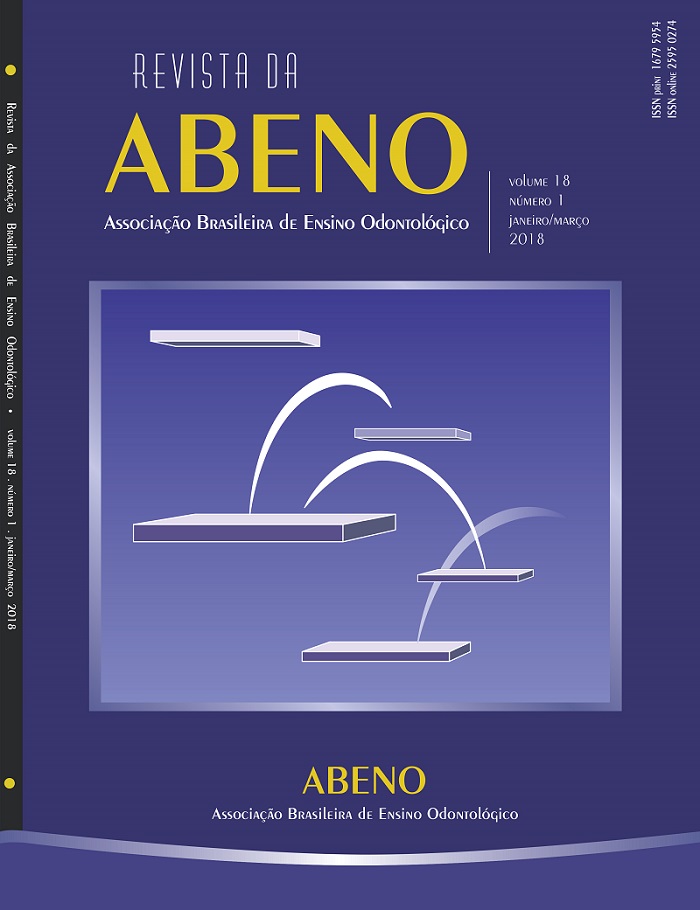Use of web-based educational technology by Brazilian oral health professionals
DOI:
https://doi.org/10.30979/rev.abeno.v18i1.415Keywords:
Distance Education. Educational Technology. Education in DentistryAbstract
The present study aimed to analyze the use of web-based educational technology on the part of dentists, and oral hygienists enrolled in a training course for offering healthcare to disabled individuals and evaluate access to the Internet, duration of the use of technological resources and objectives when using the Internet. A descriptive study was conducted with data collected from the Virtual Brazilian Dentistry Training Environment for Care Offered to Disabled Patients at the Open University Site of the Brazilian Public Healthcare System using an electronic questionnaire available on the site. The sample was composed of 2377 oral health professionals enrolled in the course who agreed to answer the questionnaire. The data were analyzed using descriptive statistics. Little more than half of the sample (54.05%) used more than one technological resource for their connection to the virtual world in their daily lives; 54.56% of the respondents accessed the Internet from their own homes, and 57.21% used a wireless/Wi-Fi system. A total of 58.9% of the sample reported that the new technological resource offers a fair degree of difficulty. The use of digital technology occurs in Brazil. While available, a large part of the population does not appear to use this technology for the purposes of continued education.
Downloads
References
McCann AL, Schneiderman ED, Hinton RJ. E-teaching and learning preferences of dental and dental hygiene students. J Dent Educ. 2010;74:65-78.
Pahinis K, Stokes CW, Walsh TF, Tsitrou E, Cannavina G. A blended learning course taught to different groups of learners in a dental school: follow-up evaluation. J Dent Educ. 2008;72:1048-57.
Pahinis K, Stokes CW, Walsh TF, Cannavina G. Evaluating a blended-learning course taught to different groups of learners in a dental school. J Dent Educ. 2007;71:269-78.
Linjawi AI, Walmsley AD, Hill KB. Online discussion boards in dental education: potential and challenges. Eur J Dent Educ. 2012;16:e3-9.
Mariño R, Habibi E, Morgan M, Au-Yeung W. Information and communication technology use among Victorian and South Australian oral health professions students. J Dent Educ. 2012;76:1667-74.
Brunet DP, Bates ML, Gallo JR, Strother EA. Incoming dental students’ expectations and acceptance of an electronic textbook program. J Dent Educ. 2011;75:646-52.
McAndrew M, Johnston AE. The role of social media in dental education. J Dent Educ. 2012;76:1474-81.
DeBate RD, Cragun D, Severson HH, Shaw T, Christiansen S, Koerber A, et al. Factors for increasing adoption of e-courses among dental and dental hygiene faculty members. J Dent Educ. 2011;75(5):589-97.
Schleyer TK, Thyvalikakath TP, Spallek H, Dziabiak MP, Johnson LA. From information technology to informatics: the information revolution in Dental education. J Dent Educ. 2012;76(1):142-53.
Denvir C, Balmer NJ, Pleasence P. Surfing the web –Recreation or resource? Exploring how young people in the UK use the Internet as an advice portal for problems with a legal dimension. Interact Computers. 2011;23:96-104.
Helsper EJ, Dutton WH, Gerber MM. To be a network society: a cross-national perspective on the internet in Britain. 2009;OII Research Report No. 17.
Eynon R, Malmberg L-E. A typology of young people’s Internet use: Implications for education. Computers & Education. 2011;56(3):585-95.
Salajan FD, Mount GJ. Leveraging the power of Web 2.0 tools: a Wiki platform as a multimedia teaching and learning environment in dental education. J Dent Educ. 2012;76:427-36.
Schoonheim M, Heyden R, Wiecha JM. Use of a virtual world computer environment for international distance education: lessons from a pilot project using Second Life. BMC Med Educ. 2014;14:36.
Uğur B, Akkoyunlu B, Kurbanoğlu S. Students’ opinions on blended learning and its implementation in terms of their learning styles. Educ Inf Technol. 2011;16:5-23.
Downloads
Published
How to Cite
Issue
Section
License
Autores que publicam nesta revista concordam com os seguintes termos:
a) Autores mantém os direitos autorais e concedem à revista o direito de primeira publicação, com o trabalho simultaneamente licenciado sob a Licença Creative Commons Attribution que permite o compartilhamento do trabalho com reconhecimento da autoria e publicação inicial nesta revista.
b) Autores têm autorização para assumir contratos adicionais separadamente, para distribuição não-exclusiva da versão do trabalho publicada nesta revista (ex.: publicar em repositório institucional ou como capítulo de livro), com reconhecimento de autoria e publicação inicial nesta revista.
c) Autores têm permissão e são estimulados a publicar e distribuir seu trabalho online (ex.: em repositórios institucionais ou na sua página pessoal) a qualquer ponto antes ou durante o processo editorial, já que isso pode gerar alterações produtivas, bem como aumentar o impacto e a citação do trabalho publicado (Veja O Efeito do Acesso Livre).







